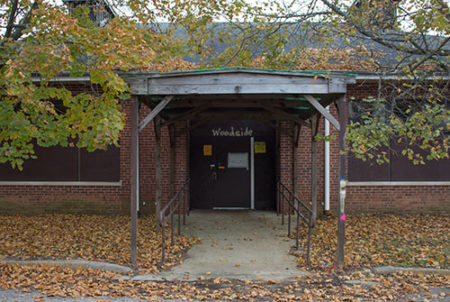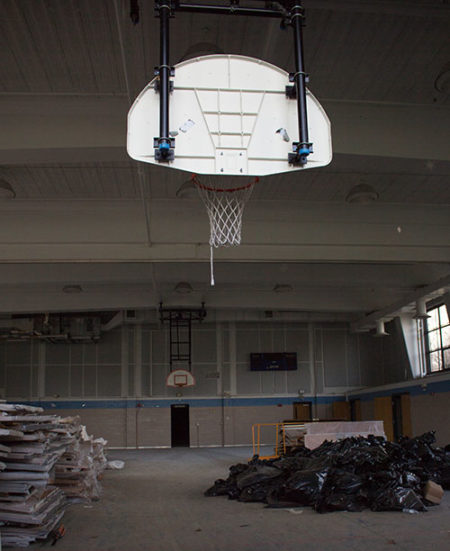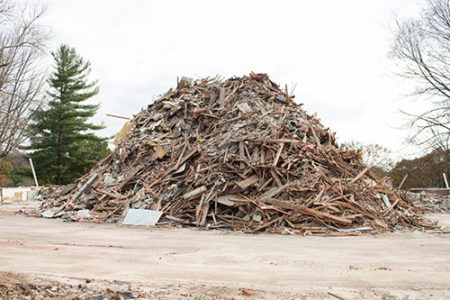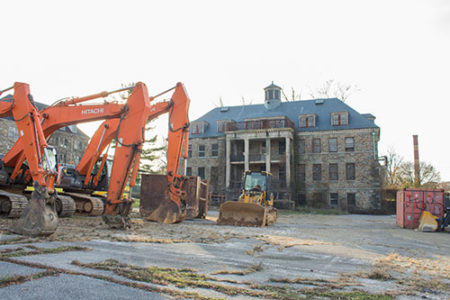After Maryland’s Board of Public Works approved the sale of the former Rosewood Center property in Owings Mills to Stevenson University for $1 in June of 2017, the university began to make use of $16 million in state grants to begin the environmental abatement and remediation of the site. When those processes are completed, the state of Maryland will transfer the final deed to 117-acre property to Stevenson University.

Stevenson does not currently own the property, according to Tim Campbell, executive vice president for financial affairs and Chief Financial Officer for Stevenson. The university will have the right to acquire the property fully once it passes a clean bill of health through the Voluntary Cleanup Program. The agreement will double Stevenson’s campus footprint, according to a Baltimore Sun article.
Since that approval, passersby on Garrison Forest Road will notice that a number of buildings have already been razed on the property that sits adjacent to Stevenson’s existing Owings Mills campus in order to make the site usable.
According to the Baltimore Business Journal, the state of Maryland provided three bond loans to the university to help pay for remediation over the next three years. Stevenson University is using none of its own money for any of the remediation projects.
HISTORY OF THE ROSEWOOD PROPERTY
In 1886, the state of Maryland allocated money needed to begin construction on the Rosewood Center, according to Dr. Glenn T. Johnston, Stevenson University archivist. The facility was fully completed and established in 1888, and opened as the Asylum and Training School for the Feeble Minded. In the year 1912, it was renamed the Rosewood State Training School.
Dr. Richard Gundry was the first superintendent of the Rosewood facility and remained there until the 1960’s. Previously the superintendent of the Spring Grove Sate Hospital, Gundry’s philosophy about the care of “feeble minded” individuals was much different than what was then established in the field. He believed that his clients needed to be outside for a specific number of hours throughout the day and that restraints were not necessary.

The Rosewood Training School was designed for individuals between 7-17 years of age who essentially could not thrive in the real world on their own. The belief was that with good care and treatment, along with a sense of feeling involved and important, allowed the inmates, now called clients, to achieve a sense of satisfaction with their lives.
According to Johnston, the majority of the facility was a self-supporting farm, complete with agriculture and livestock. The clients regularly practiced agricultural and animal care. The men learned carpentry, and they aided in the construction of multiple buildings and gates on the property. They also learned how to put out fires due to the large acreage of the facility. The women were trained in housekeeping and cleaning, which included sweeping, dusting and washing, as well as training for domestic service. They also learned sewing and kitting, for a majority of the clothing and table linens were handmade.
Beginning in the 1920s, the Rosewood State Training School held a spring fair allowing the clients an opportunity to sell the items they had crafted throughout the year. The women sold scarves and mittens, and the men sold wooden items they had built. The clients could then keep any money earned and save it if or until they were discharged, explained Johnston.
In 1961, the facility was renamed the Rosewood State Hospital, only to be renamed again the Rosewood Center shortly after the Maryland State Departments of Health and Mental Hygiene merged, said Johnston. At this time during the 20th century, the facility grew, and the number of clients increased rapidly. The age restriction of the facility had also been lifted, and by 1968, the Rosewood Center had approximately 2,700 patients.
After that, funding for the institution did not meet the requirements necessary to keep it running smoothly, and thus the Rosewood Center began its decline. Nurses working at the facility went from tending to six patients to monitoring 32 at any given time. By the 1980s the U.S. Justice Department declared that the Rosewood Center clients were not receiving the adequate care they needed to thrive. On June 30, 2009, the State of Maryland Department of Health and Mental Hygiene closed the Rosewood Center, and it was abandoned so abruptly that it appears today as time had simply stopped on the campus, explained Johnston.
ROSEWOOD IN THE PRESENT DAY
According to a Stevenson University press release, the empty buildings on the Rosewood site, as well as the possibility of contaminants, have concerned the Garrison/Owings Mills community for many years. Stevenson first expressed interest in acquiring the property in 2000 and within the decade conducted an environmental survey of the site.
According to the Baltimore Sun, “the deed agreement would require Stevenson to use the property for educational purposes for at least 15 years.”

The state’s Department of General Services has noted that the Rosewood site now “represents a blighted area and a nuisance” and has been the site of vandalism and other crimes since its closure. Since 2010, according to the Baltimore Sun, the department said the state has spent $17 million to maintain the property. The parcel of property that Stevenson acquired (117 acres out of the original 276 acres) contains 18 buildings that appear to be beyond repair.
Demolition has already begun on 18 buildings, most of which can be seen from Garrison Forest Road. For the buildings to be approved for demolition, the electricity, gas and water outlets had to be capped appropriately, and buildings with asbestos and other contaminants had be cleared. Stevenson is partnering with Urban Green Environmental, one of the top environmental firms in the state, to confirm that the buildings are being demolished using all the necessary precautions. After a building has been demolished, the rubble remains stationary on the slab on which it was built. This is to ensure no cross-contamination occurs, explained Campbell.
On the slabs, the rubble is separated into different piles including wood, metal, brick and waste. According to Leland Beitel, assistant vice president of facilities and campus services, the project is undergoing an extensive recycling program, and anything that has potential will be recycled.
Once all the buildings have been properly demolished and debris has been disposed of, then the land can be graded. This process will take the longest amount of time, due to the hilly area and multiple athletic fields being built in place. The connection between the adjacent Stevenson areas will need to be completed as well. If the plan is successful, building on the land will commence in late 2019.
STEVENSON’S PLAN FOR THE PROPERTY
The plan for the 117-acre property is exciting still very tentative, said Campbell. Due to the property’s close proximity to the surrounding residential properties, the Garrison/Owings Mills community wanted something to be built that fit appropriately into the area and included facilities that they could also utilize.

Initial plans for the new campus area may include an indoor pool, an ice hockey rink and field house, a softball field, a baseball field, tennis courts and multiple athletic fields, walking paths and large spans of green space, available for use by both the Stevenson and Garrison/Owings Mills community, according to Campbell. There will be a vegetational blockade between the remaining historical Rosewood buildings owned by the state and the new athletic facilities. A memorial to commemorate the history of the Rosewood Center and its clients is under consideration.
Two new bridges are being proposed: a walking path, going from the Owings Mills campus to the Rosewood area, and a walking/vehicular bridge going from Owings Mills North to the new Rosewood property, in hopes of reducing vehicle traffic on Garrison Forest Road.
The three Owings Mills areas will each become a hub for specific activities: Owings Mills being the core of student life and housing, Owings Mills North as the core of academics, and the new area serving as the core of athletics.
According to Campbell, the plan fits both the intent and theme of the Garrison/Owings Mills and Stevenson community vision, with no massive building and a lot of green space. It can be a very positive thing for Stevenson and the surrounding community, said Campbell.

























































